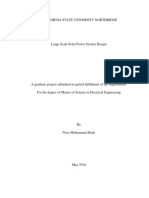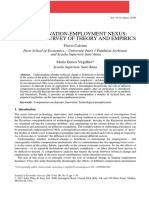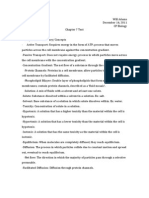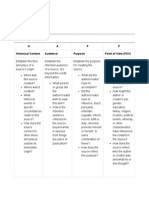Procedures For Solar Electric (Photovoltaic Abbreviated As PV) System Design and Installation
Procedures For Solar Electric (Photovoltaic Abbreviated As PV) System Design and Installation
Uploaded by
Umamaheshwarrao VarmaCopyright:
Available Formats
Procedures For Solar Electric (Photovoltaic Abbreviated As PV) System Design and Installation
Procedures For Solar Electric (Photovoltaic Abbreviated As PV) System Design and Installation
Uploaded by
Umamaheshwarrao VarmaOriginal Description:
Original Title
Copyright
Available Formats
Share this document
Did you find this document useful?
Is this content inappropriate?
Copyright:
Available Formats
Procedures For Solar Electric (Photovoltaic Abbreviated As PV) System Design and Installation
Procedures For Solar Electric (Photovoltaic Abbreviated As PV) System Design and Installation
Uploaded by
Umamaheshwarrao VarmaCopyright:
Available Formats
PV Design and Installation
Page 1, Section 4: Installation Checklist
PROCEDURES FOR SOLAR ELECTRIC (PHOTOVOLTAIC abbreviated as PV)
SYSTEM DESIGN AND INSTALLATION
SECTION 4: SOLAR ELECTRIC (PV) SYSTEM INSTALLATION CHECKLIST
Following the completion of each item on the checklist below, check the box to the left of the item and
insert the date and initials of the person completing the item. Stars (*) denote items that should be checked
directly by the field superintendent with the installing contractor.
Before starting any PV system testing: (hard hat and eye protection required)
! 1. Check that non-current carrying metal parts are grounded properly (array frames, metal boxes,
etc. are connected to the grounding system).
! 2. Ensure that all labels and safety signs specified in the plans are in place.
! 3. Verify that all disconnect switches (from the main AC disconnect all the way through to the
combiner fuse switches) are in the open position and tag each box with a warning sign to signify that work on
the PV system is in progress.
PV ARRAY--General (hard hat, gloves, and eye protection required)
! 1. Verify that all combiner fuses are removed and that no voltage is present at the output of the
combiner box.
! *2. Visually inspect any plug and receptacle connectors between the modules and panels to
ensure they are fully engaged.
! *3. Check that strain reliefs/cable clamps are properly installed on all cables and cords by pulling
on cables to verify.
! *4. Check to make sure all panels are attached properly to their mounting brackets and nothing
catches the eye as being abnormal or misaligned.
! *5. Visually inspect the array for cracked modules.
! *6. Check to see that all wiring is neat and well supported.
PV ARRAY CIRCUIT WIRING (hard hat and eye protection required)
! 1. Check home run wires (from PV modules to combiner box) at DC string combiner box to
ensure there is no voltage on them.
ConSol March 2001
PV Design and Installation
Page 2, Section 4: Installation Checklist
! 2. Recheck that fuses are removed and all switches are open.
! 3. Connect the home run wires to the DC string combiner box terminals in the proper order and
make sure labeling is clearly visible.
REPETITIVE SOURCE CIRCUIT STRING WIRING (hard hat, gloves, and eye protection, required) (The
following procedure must be followed for each source circuit string in a systematic approach(i.e. east to west or north
to south).) Ideal testing conditions are midday on cloudless days March through October.
! 4. Check open-circuit voltage of each of the panels in the string being wired to verify that it
provides the manufacturers specified voltage in full sun. (Panels under the same sunlight conditions should
have similar voltages--beware of a 20 Volt or more shift under the same sunlight conditions.)
! 5. Verify that the both the positive and negative string connectors are identified properly with
permanent wire marking.
! 6. Repeat this sequence for all source circuit strings.
CONTINUATION OF PV ARRAY CIRCUIT WIRING (hard hat, gloves, and eye protection required)
! 7. Recheck that DC Disconnect switch is open and tag is still intact.
! 8. VERIFY POLARITY OF EACH SOURCE CIRCUIT STRING in the DC String Combiner
Box (place common lead on the negative grounding block and the positive on each string connection--pay
particular attention to make sure there is NEVER a negative measurement). Verify open-circuit voltage is
within proper range according to manufacturers installation manual and number each string and note string
position on as-built drawing. (voltages should match closely if sunlight is consistent)
NOTE: IF POLARITY OF ONE SOURCE CIRCUIT STRING IS REVERSED, THIS CAN START A FIRE IN THE
FUSE BLOCK RESULTING IN THE DESTRUCTION OF THE COMBINER BOX AND POSSIBLY ADJACENT
EQUIPMENT. REVERSE POLARITY ON AN INVERTER CAN ALSO CAUSE DAMAGE THAT IS NOT
COVERED UNDER THE EQUIPMENT WARRANTY.
! 9. Retighten all terminals in the DC String Combiner Box.
WIRING TESTS--Remainder of System: (hard hat, gloves, and eye protection required)
! 10. Verify that the only place where the AC neutral is grounded is at the main service panel.
ConSol March 2001
PV Design and Installation
Page 3, Section 4: Installation Checklist
! 11. Check the AC line voltage at main AC disconnect is within proper limits (115-125 Volts AC
for 120 Volts and 230-250 for 240 Volts).
! 12. If installation contains additional AC disconnect switches, repeat the step 11 voltage check on
each switch working from the main service entrance to the inverter AC disconnect switch, closing each switch
after the test is made except for the final switch before the inverter (it is possible that the system only has a
single AC switch).
INVERTER STARTUP TESTS (hard hat, gloves, and eye protection required)
! 1. Be sure that the inverter is off before proceeding with this section.
! 2. Test the continuity of all DC fuses to be installed in the DC string combiner box, install all
string fuses, and close fuse switches in combiner box.
! 3. Check open circuit voltage at DC disconnect switch to ensure it is within proper limits
according to the manufacturers installation manual.
! 4. If installation contains additional DC disconnect switches, repeat the step 4 voltage check on
each switch working from the PV array to the inverter DC disconnect switch, closing each switch after the test
is made except for the final switch before the inverter (it is possible that the system only has a single DC
switch).
! *5. At this point consult the inverter manual and follow proper startup procedure (all power to the
inverter should be off at this time).
! *6. Confirm that the inverter is operating and record the DC operating voltage here: ________.
! *7. Confirm that the operating voltage is within proper limits according to the manufacturers
installation manual.
! 8. After recording the operating voltage at the inverter, close any open boxes related to the
inverter system.
! *9. Confirm that the inverter is producing the expected power output on the supplied meter.
! *10. Provide the homeowner with the initial startup test report.
ConSol March 2001
PV Design and Installation
Page 4, Section 4: Installation Checklist
*SYSTEM ACCEPTANCE TEST (hard hat and eye protection required)
Ideal testing conditions are midday on cloudless days March through October. However, this test procedure accounts for
less than ideal conditions and allows acceptance tests to be conducted on sunny winter days.
! *1. Check to make sure that the PV array is in full sun with no shading whatsoever. If it is
impossible to find a time during the day when the whole array is in full sun, only that portion that is in full sun
will be able to be accepted.
!
*2. If the system is not operating, turn the system on and allow it to run for 15 minutes before
taking any performance measurements.
!
*3. Obtain solar irradiance measurement by one of two methods and record irradiance here:
W/m . To obtain percentage of peak sun divide irradiance by 1000 W/m2 and record the value here:
2
. (example: 692 W/m2 1000 W/m2 = 0.692 or 69.2%.)
Method 1: Take measurement from calibrated solar meter or pyranometer.
Method 2: Place a single, properly operating PV module, of the same model found in the array, in full sun in the
exact same orientation as the array being tested. After 15 minutes of full exposure, test the short circuit current
with a digital multimeter and place that reading here: Amps. Divide this number into the short circuit
current (Isc) value printed on the back of the PV module and multiply this number by 1000 W/m2 and record the
value on the line above. (example: Isc-measured = 3.6 Amps; Isc-printed on module = 5.2 Amps; Irradiance =
3.6 Amps/5.2 Amps * 1000 W/m2 = 692 W/m2)
! *4. Sum the total of the module ratings and place that total here: WattsSTC. Multiply
this number by 0.7 to obtain expected peak AC output and record here:
WattsAC-estimated.
! *5. Record AC Watt output from the inverter or system meter and record here:
WattsAC-measured.
! *6. Divide WattsAC-measured by percent peak irradiance and record here:
WattsAC-corrected. This AC-corrected value is the rated output of PV system. This number must be
within 90% or higher of WattsAC-estimated recorded in step 4. If it is less than 90%, the PV system is either shaded,
dirty, miswired, fuses are blown, or the modules or inverter are not operating properly.
Example Test:
A PV system is made up of 20, 100 WattSTC PV modules operating at an estimated irradiance of 692 W/m2 using method
2 shown above. The power output is measured to be 1000 WattsAC-measured at the time of the test. Is this system operating
properly or not?
ConSol March 2001
PV Design and Installation
Page 5, Section 4: Installation Checklist
Example Solution:
Sum of module ratings = 100 WattsSTC per module x 20 modules = 2,000 WattsSTC.
Estimated AC power output = 2,000 WattsSTC x 0.7 = 1,400 WattsAC-estimated.
Measured AC output = 1,000 WattsAC-measured.
Corrected AC output = 1,020 WattsAC-corrected 0.692 = 1,474 WattsAC-corrected.
Comparison of corrected and estimated outputs: 1,474 WattsAC-corrected 1,400 WattsAC-estimated = 1.05, which is 0.9,
demonstrating acceptable performance
ConSol March 2001
You might also like
- PTM Falcon 10 100Document678 pagesPTM Falcon 10 100Fidel Arellano100% (3)
- Dismantling LetterDocument1 pageDismantling LetterUmamaheshwarrao VarmaNo ratings yet
- AISI 1018 Carbon Steel (UNS G10180) : Topics CoveredDocument4 pagesAISI 1018 Carbon Steel (UNS G10180) : Topics CoveredPablo MenendezNo ratings yet
- Experiment 7 - Salivary Amylase PH and TemperatureDocument5 pagesExperiment 7 - Salivary Amylase PH and Temperatureshr sem0% (1)
- Title of The Drawing or Document:-: Single Line Diagram AcDocument3 pagesTitle of The Drawing or Document:-: Single Line Diagram AcAnil PooniaNo ratings yet
- Sld-Single Line Diagram Ac: Development of NTPC 2 X 65 MWP Solar PV Power Project (P5 & P6 Block) in Badhla, RajasthanDocument4 pagesSld-Single Line Diagram Ac: Development of NTPC 2 X 65 MWP Solar PV Power Project (P5 & P6 Block) in Badhla, RajasthanAnil PooniaNo ratings yet
- Acme-kr1-01-Ee-224-Ts-001 - r0 Bay End Etc - Technical SpecificationDocument74 pagesAcme-kr1-01-Ee-224-Ts-001 - r0 Bay End Etc - Technical SpecificationUmamaheshwarrao VarmaNo ratings yet
- 50 AND 30 MW PV PLANT Allied Components and Systems STUDYDocument234 pages50 AND 30 MW PV PLANT Allied Components and Systems STUDYhaniNo ratings yet
- 84.32 KWP Hope Hall RK Puram SLD E-02Document1 page84.32 KWP Hope Hall RK Puram SLD E-02Sunil SinghNo ratings yet
- Substation Ratings - SpecificationDocument14 pagesSubstation Ratings - SpecificationjackthonetNo ratings yet
- Feasibility Analysis of Floating Solar Photovoltaic Plant at Srisailam in Andhra Pradesh IndiaDocument7 pagesFeasibility Analysis of Floating Solar Photovoltaic Plant at Srisailam in Andhra Pradesh Indiasinghharsha1307No ratings yet
- Predesign Pile Foundation EGYPT STERLING WILSON Draft v10.1 August 2018Document41 pagesPredesign Pile Foundation EGYPT STERLING WILSON Draft v10.1 August 2018ramesNo ratings yet
- Abaarey PS - PV Solar Power Design ReportDocument9 pagesAbaarey PS - PV Solar Power Design ReportmarleoenterprisesNo ratings yet
- SOW SolarDocument3 pagesSOW SolarMohammed BayrakdarNo ratings yet
- 91mwac Layla PV Project in Saudi ArabiaDocument1 page91mwac Layla PV Project in Saudi ArabiaPriyanka GuleriaNo ratings yet
- Capacity, PR and RR Test Procedure v2.0Document8 pagesCapacity, PR and RR Test Procedure v2.0Mun Haeng PhonNo ratings yet
- How Should I Design Earthing of A Solar Plant - QuoraDocument7 pagesHow Should I Design Earthing of A Solar Plant - QuoraMuhammed MekkiNo ratings yet
- Revised GIS of 50 MW Sinowell WPPDocument344 pagesRevised GIS of 50 MW Sinowell WPPtayyab zafarNo ratings yet
- Dhabli - 1axis Tracker PVSYSTDocument5 pagesDhabli - 1axis Tracker PVSYSTLakshmi NarayananNo ratings yet
- Large Scale Solar Power System DesignDocument90 pagesLarge Scale Solar Power System Design김동욱No ratings yet
- Solar Generator Design Calculator: Step 1: Inventory Your Devices InstructionsDocument5 pagesSolar Generator Design Calculator: Step 1: Inventory Your Devices InstructionsJean-Max RigaudNo ratings yet
- Scope of Work For The Supply and Installation of Solar Power SystemDocument12 pagesScope of Work For The Supply and Installation of Solar Power SystemAzizullah AlizayNo ratings yet
- Lcoe Analysis MP 03-07-17 (CBS)Document5 pagesLcoe Analysis MP 03-07-17 (CBS)Jorge Isaac Flores SamaniegoNo ratings yet
- Boq - 2021.04.13Document157 pagesBoq - 2021.04.13Romdhani HamedNo ratings yet
- 1C 16SQMM CU Cable AJB: Internet ConnectionDocument1 page1C 16SQMM CU Cable AJB: Internet ConnectionShivi AroraNo ratings yet
- 2 - Sample - Report Floating Solar Power PlantDocument33 pages2 - Sample - Report Floating Solar Power Plantjoshikaustubhp070No ratings yet
- Design and Evaluation of Earthing and Lightning Arrester For Grid Connected Solar Prototype SystemDocument5 pagesDesign and Evaluation of Earthing and Lightning Arrester For Grid Connected Solar Prototype SystemPablo di PasquoNo ratings yet
- Floating Solar Power Plant - Google ScholarDocument2 pagesFloating Solar Power Plant - Google ScholarJames KazoobaNo ratings yet
- Solar/Wind/Diesel Hybrid Energy System With Battery Storage For Rural ElectrificationDocument15 pagesSolar/Wind/Diesel Hybrid Energy System With Battery Storage For Rural ElectrificationWelde AynaleNo ratings yet
- System Earthing: 2007 Homepower Article, 'Get Grounded'Document4 pagesSystem Earthing: 2007 Homepower Article, 'Get Grounded'JohnNo ratings yet
- Design Floating PVDocument9 pagesDesign Floating PVAchmad HidayatNo ratings yet
- Solar PV Tester and I-V Curve Tracer: Key FeaturesDocument6 pagesSolar PV Tester and I-V Curve Tracer: Key FeaturesReynanteNo ratings yet
- String SizingDocument1 pageString SizingAnkit kumarNo ratings yet
- Distribution Transformer Calculations: Developed By: Mahmoud SalamaDocument1 pageDistribution Transformer Calculations: Developed By: Mahmoud SalamaBalamurugan ArumugamNo ratings yet
- 10MW Solar - Bhel Tech. Specification PDFDocument217 pages10MW Solar - Bhel Tech. Specification PDFHeera RamjiNo ratings yet
- PS-439-1173 BOS Spec For Trichy 7.5MW PDFDocument35 pagesPS-439-1173 BOS Spec For Trichy 7.5MW PDFmohan babu100% (1)
- DTTN Dt2 PC Met PW 0003 ADocument8 pagesDTTN Dt2 PC Met PW 0003 ATariq Ali SialNo ratings yet
- PV Brochure 150dpi en 02Document12 pagesPV Brochure 150dpi en 02Sabit SadriajNo ratings yet
- Single Line Diagram BD1-13 Rev.01Document8 pagesSingle Line Diagram BD1-13 Rev.01Tashin WongprasertsiriNo ratings yet
- Tges Karnataka 29 MWDocument5 pagesTges Karnataka 29 MWVamsiNo ratings yet
- Investigating The Effect of Orientation and Tilt Angle On Bifacial PV Modules On Vertical EastDocument5 pagesInvestigating The Effect of Orientation and Tilt Angle On Bifacial PV Modules On Vertical EastSumit TyagiNo ratings yet
- Lightning Protection of Photovoltaic SysDocument12 pagesLightning Protection of Photovoltaic SysWinSajeewaNo ratings yet
- Lightning Protection of PV SystemsDocument15 pagesLightning Protection of PV SystemskarlNo ratings yet
- Design PV WasiniDocument32 pagesDesign PV WasiniKevin Kimani MainaNo ratings yet
- 1MW Grid-Connected PV System Design PlanDocument10 pages1MW Grid-Connected PV System Design PlanengmswilamNo ratings yet
- Indelec - Prevectron Lightning Protection SolutionsDocument2 pagesIndelec - Prevectron Lightning Protection SolutionsBalasubramani GNo ratings yet
- Bhel Bess CorrigendumDocument96 pagesBhel Bess CorrigendumankitNo ratings yet
- PV Grid Integration: Backgrounds, Requirements, and SMA SolutionsDocument36 pagesPV Grid Integration: Backgrounds, Requirements, and SMA SolutionsParthibanPerumalNo ratings yet
- Bifacial WorkshopDocument14 pagesBifacial WorkshopDavid GarciaNo ratings yet
- 1500 V - Hauwei Module Confugration - 15-01-2019-R3Document4 pages1500 V - Hauwei Module Confugration - 15-01-2019-R3arunghandwalNo ratings yet
- Busbar SizingDocument6 pagesBusbar Sizingcosmin75No ratings yet
- PV Layout FinalDocument1 pagePV Layout FinalRahul SahaNo ratings yet
- RatedPower PvDesign Energy Methodology ReportDocument111 pagesRatedPower PvDesign Energy Methodology Reportlos_erizosNo ratings yet
- CIKIT - Product CatalogueDocument20 pagesCIKIT - Product CatalogueMithun KamathNo ratings yet
- DPRDocument104 pagesDPRAditya GhatgeNo ratings yet
- TBEA Solar Solution - State of Kedah, Malaysia, Tungku ContactDocument51 pagesTBEA Solar Solution - State of Kedah, Malaysia, Tungku Contactdavidwong100% (2)
- Techno Commercial NEPL 089 R00Document11 pagesTechno Commercial NEPL 089 R00Darshit VyasNo ratings yet
- Solar Generations Impact On Fault CurrentDocument32 pagesSolar Generations Impact On Fault CurrentchintanpNo ratings yet
- 10194601-DS-0201 - B - SubstationDocument48 pages10194601-DS-0201 - B - SubstationCarlosNo ratings yet
- Solar PV SystemDocument40 pagesSolar PV SystemAbdullahNo ratings yet
- Imc 35 MLD Dep Ee Dat 08 r2Document4 pagesImc 35 MLD Dep Ee Dat 08 r2Electrical RadicalNo ratings yet
- Danfoss String Inverters Vs Central InvertersDocument14 pagesDanfoss String Inverters Vs Central InvertersJacinto Benavente FuertesNo ratings yet
- Procedures For Solar Electric (Photovoltaic Abbreviated As PV) System Design and InstallationDocument5 pagesProcedures For Solar Electric (Photovoltaic Abbreviated As PV) System Design and InstallationVinit JhingronNo ratings yet
- 3 Section-5 Technical Specification (Annexure-B)Document102 pages3 Section-5 Technical Specification (Annexure-B)Umamaheshwarrao VarmaNo ratings yet
- An Example of Transformer Tap-Changer Correct AdjustmentDocument5 pagesAn Example of Transformer Tap-Changer Correct AdjustmentUmamaheshwarrao VarmaNo ratings yet
- Transformer Manufacturing Process Training ReportDocument74 pagesTransformer Manufacturing Process Training ReportUmamaheshwarrao VarmaNo ratings yet
- Lighting Arrestor Foundation Details 200 MM J BOLT-ModelDocument1 pageLighting Arrestor Foundation Details 200 MM J BOLT-ModelUmamaheshwarrao VarmaNo ratings yet
- MR Developers Plumbing - ITIDocument31 pagesMR Developers Plumbing - ITIUmamaheshwarrao Varma100% (1)
- TAQC Inspection Waivel Asif SirDocument1 pageTAQC Inspection Waivel Asif SirUmamaheshwarrao VarmaNo ratings yet
- Aux TF 630 KvaDocument7 pagesAux TF 630 KvaUmamaheshwarrao VarmaNo ratings yet
- Erection Updated Revenue 27.4.2019Document95 pagesErection Updated Revenue 27.4.2019Umamaheshwarrao VarmaNo ratings yet
- CV Uma 10.11.2018Document2 pagesCV Uma 10.11.2018Umamaheshwarrao VarmaNo ratings yet
- DG Check ListDocument1 pageDG Check ListUmamaheshwarrao VarmaNo ratings yet
- Name Plate Details of ELECTRICAL EQUIPMENTS at ITI SiteDocument5 pagesName Plate Details of ELECTRICAL EQUIPMENTS at ITI SiteUmamaheshwarrao VarmaNo ratings yet
- Price Comparison For 220 KV CTT MC TowerDocument1 pagePrice Comparison For 220 KV CTT MC TowerUmamaheshwarrao VarmaNo ratings yet
- Measurement Sheet - Site Construction - Ra01xlsDocument1 pageMeasurement Sheet - Site Construction - Ra01xlsUmamaheshwarrao VarmaNo ratings yet
- Ramya ResumeDocument2 pagesRamya ResumeUmamaheshwarrao VarmaNo ratings yet
- Price Comparison For 220 KV CTT MC TowerDocument1 pagePrice Comparison For 220 KV CTT MC TowerUmamaheshwarrao VarmaNo ratings yet
- Test ListDocument8 pagesTest ListUmamaheshwarrao VarmaNo ratings yet
- Online - Support@apsrtconline - In: ID Proof NoteDocument1 pageOnline - Support@apsrtconline - In: ID Proof NoteUmamaheshwarrao VarmaNo ratings yet
- Name Plate Details1Document8 pagesName Plate Details1Umamaheshwarrao VarmaNo ratings yet
- Name Plate Details of ELECTRICAL EQUIPMENTS at ITI SiteDocument5 pagesName Plate Details of ELECTRICAL EQUIPMENTS at ITI SiteUmamaheshwarrao VarmaNo ratings yet
- Work Stop Notice - Quality: Signature (SWN Issued By)Document1 pageWork Stop Notice - Quality: Signature (SWN Issued By)Umamaheshwarrao VarmaNo ratings yet
- Water ProofingDocument2 pagesWater ProofingUmamaheshwarrao VarmaNo ratings yet
- S.No Description 220 KV Gis 66 KV Gis Control Room BuildingDocument1 pageS.No Description 220 KV Gis 66 KV Gis Control Room BuildingUmamaheshwarrao VarmaNo ratings yet
- Hydro vs. Wind vs. Solar Power?: Water, Wind or Sun?Document4 pagesHydro vs. Wind vs. Solar Power?: Water, Wind or Sun?Umamaheshwarrao VarmaNo ratings yet
- M/s Bhupendra Kumar: Building Material SupplierDocument1 pageM/s Bhupendra Kumar: Building Material SupplierUmamaheshwarrao VarmaNo ratings yet
- Turbine Cable Aw G 1Document2 pagesTurbine Cable Aw G 1Umamaheshwarrao VarmaNo ratings yet
- Technical and Operational Definitions SlemDocument7 pagesTechnical and Operational Definitions SlemMa'am WengNo ratings yet
- Gujarat Technological UniversityDocument2 pagesGujarat Technological Universityvifaket581No ratings yet
- SMC Learning Module For Students in NLP001 1Document44 pagesSMC Learning Module For Students in NLP001 1Ladylen DeeNo ratings yet
- Project Profile Elc270Document5 pagesProject Profile Elc270PronnykaNo ratings yet
- Annual Mathlympics For All Singapore Primary Schools 2020: Annex ADocument2 pagesAnnual Mathlympics For All Singapore Primary Schools 2020: Annex AStop Motion AnimationsNo ratings yet
- Structural Calculation of Box Culvert Type: B1.00m X H1.00m Class V Road Soil Cover Depth: 0.0 M 1 Dimensions and ParametersDocument29 pagesStructural Calculation of Box Culvert Type: B1.00m X H1.00m Class V Road Soil Cover Depth: 0.0 M 1 Dimensions and ParametersBambang ZidaneNo ratings yet
- SQL Joins Explained: Basic SQL Join TypesDocument7 pagesSQL Joins Explained: Basic SQL Join TypesG.DNo ratings yet
- Housing SurveyDocument27 pagesHousing SurveyGeetakshri JajoriaNo ratings yet
- MS For Windows - Louvres InstallationDocument9 pagesMS For Windows - Louvres InstallationGary LoNo ratings yet
- Calvino, Virgillito (2018) - The Innovation Employment Nexus. A Critical Survey of Theory and EmpiricsDocument35 pagesCalvino, Virgillito (2018) - The Innovation Employment Nexus. A Critical Survey of Theory and Empiricsverdi rossiNo ratings yet
- NJS3 - DatasheetDocument2 pagesNJS3 - DatasheetSERGIO GIRABELNo ratings yet
- IGCSE Global Perspectives: How Do I Conduct An Independent Research Project?Document11 pagesIGCSE Global Perspectives: How Do I Conduct An Independent Research Project?suzy2pugh2824100% (1)
- 05-06-07 PressureDocument34 pages05-06-07 PressureDiana MoralesNo ratings yet
- UNIDAD 1 MyELT Desarrollo ContinuaDocument27 pagesUNIDAD 1 MyELT Desarrollo ContinuaJacob López GarridoNo ratings yet
- Music Preferences and The Adolescent Brain: A Review of LiteratureDocument7 pagesMusic Preferences and The Adolescent Brain: A Review of LiteratureRocíoNo ratings yet
- Weekly Learning Plan Q1W1Document2 pagesWeekly Learning Plan Q1W1sagiNo ratings yet
- Barangay Claro M. Recto Historical Background: Demographic ProfileDocument5 pagesBarangay Claro M. Recto Historical Background: Demographic ProfileTherese PinedaNo ratings yet
- Chapter 7 Bio Test Study Guide ADocument3 pagesChapter 7 Bio Test Study Guide ARachel FrankenfieldNo ratings yet
- A001070 - 01E Preservation SpecDocument101 pagesA001070 - 01E Preservation SpecTaz Uddin100% (1)
- Proposal - Training For Bangladesh Government Officials 2Document7 pagesProposal - Training For Bangladesh Government Officials 2Mohd Zaki Mohd YaacobNo ratings yet
- Impact of Store Atmosphere in Purchase Decision in Clothing Stores of KathmanduDocument9 pagesImpact of Store Atmosphere in Purchase Decision in Clothing Stores of Kathmandudiya shresthaNo ratings yet
- FNB Premier Cheque Account 70Document7 pagesFNB Premier Cheque Account 70paulthulaningubaneNo ratings yet
- 5 6138936303955215003Document28 pages5 6138936303955215003GEO MERINNo ratings yet
- BT5RDocument10 pagesBT5RNikka Noelle MiguelNo ratings yet
- Apush Hap-PDocument2 pagesApush Hap-PVi HuynhNo ratings yet
- Agile Landscape: LAST 2016Document29 pagesAgile Landscape: LAST 2016MbellattiNo ratings yet
- Barista Guide VBM UpdateDocument25 pagesBarista Guide VBM UpdateinasNo ratings yet


















































































































